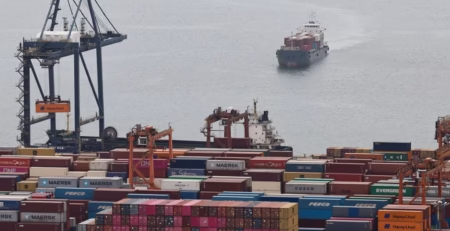Asia–US Spot Rates Show a Fragile Rebound as Carriers Tighten Capacity

After nearly three months of rate erosion, the trans-Pacific container market has shown its first meaningful uptick. Freight indices out of Asia ticked higher last week, offering a short-lived breather to carriers still battling soft demand and excess capacity.
According to the latest Drewry World Container Index, spot rates from Shanghai to Los Angeles rose by roughly 6 percent week on week, while Shanghai to New York climbed about 4 percent. The gains follow a wave of blank sailings and ad-hoc vessel repositionings as carriers attempt to restore pricing discipline before the holiday slowdown.
A Pause in the Slide, Not a Turnaround
The rebound comes after a long downward drift that began in mid-August, when retail demand from the United States weakened and inventories remained high across major importers.
Analysts caution that this modest recovery does not mark the start of a sustained rally.
“It’s a tactical correction, not a structural one,” explained a senior rate analyst based in Singapore.
“Carriers have pulled enough tonnage to squeeze space temporarily, but the fundamentals are still soft.”
Behind the scenes, most shipping lines are quietly withdrawing low-yield sailings, especially on the US West Coast, where spot rates had fallen dangerously close to breakeven. The strategy is to protect what remains of profit margins through selective capacity control rather than broad-scale rate hikes.
Shippers Locking in November
Many US importers and freight forwarders are taking advantage of the brief price stability to secure November allocations before the next wave of rate volatility. Forwarders report that premium-service surcharges have reappeared on certain high-demand sailings to Los Angeles and Seattle, while East Coast bookings remain subdued.
For cargo owners, the message is mixed: now may be the best window to finalize year-end shipments, but no one expects sustained strength unless consumer spending improves through December.
Capacity Still Weighs on the Market
New tonnage continues to enter the global fleet. With delivery schedules still running heavy from earlier ship orders, global capacity is set to rise by more than 7 percent year on year, keeping pressure on rates well into 2026.
Even with dozens of blank sailings announced for November, analysts estimate that at least 20 percent of scheduled capacity remains underutilized across major Asia–US routes.
Outlook: A Cautious Calm
Freight forwarders describe the current moment as a “calm plateau” — a pause before either seasonal relief or another slide.
Much will depend on retail re-ordering patterns and US consumer confidence through Black Friday and the Christmas build-up. If spending falters again, carriers may have little choice but to roll out new rounds of rate cuts in early January.
For now, though, the market has caught its breath.
Carriers have stemmed the bleeding, shippers are booking space, and the ocean-freight chessboard feels momentarily balanced — if only until the next move.
The post Asia–US Spot Rates Show a Fragile Rebound as Carriers Tighten Capacity appeared first on The Logistic News.
Share this post
Related
Posts
US–China Port Fees on Hold: A Fragile Calm at Sea
There’s finally a pause in a dispute that has kept shipping executives awake for weeks.The United States and China have...
Asia–US Spot Rates Show a Fragile Rebound as Carriers Tighten Capacity
After nearly three months of rate erosion, the trans-Pacific container market has shown its first meaningful uptick. Freight indices out...
Post Title
In airfreight operations, most managers can tell you exactly how many tonnes moved last month or how many ULDs turned...
Stellantis Reports a Strong Quarter but Keeps Its Guard Up Over U.S. Tariffs
The morning began with good news for Stellantis — revenue for the third quarter reached €37.2 billion, a rise of...





